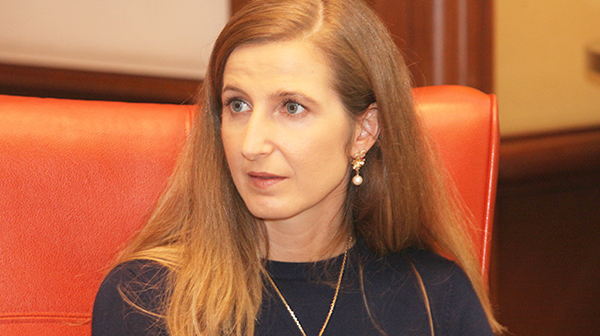 Sonja Neuber is the Digital Marketing Director at Stealth Startup. Based in UAE, she brings her unique perspective on e-commerce, digital strategy and emerging markets.
Sonja Neuber is the Digital Marketing Director at Stealth Startup. Based in UAE, she brings her unique perspective on e-commerce, digital strategy and emerging markets.
Key Learnings:
1. Now, non-conventional e-commerce companies are looking to go more digital; real estate is a great example of this.
2. The digital landscape is quite different in UAE than it was five years ago since content consumption has changed so much toward a more digital focus, and mobile is a huge driver.
3. The players who do well with data-driven decision-making are mostly those who work solely in the online space.
4. The challenges of digital marketing in UAE are finding the right candidates for the job, figuring out how to process and automate data, combining data sources, and correctly using the data to influence company decisions.
5. Never think something might not work without trying it first. You might have many ideas, and you will fail a lot. Don’t be shy about testing, because you never know when you’ll discover something new.
Interview:
AS: This is Amin Shawki, the Regional Managing Director for InfoTrust here in MENA. I’m with Sonja Neuber, a seasoned Marketing Executive who is also located in the MENA region. Thanks so much for joining us, Sonja. Great. So this is take II. Let’s start off with the first question. How would you introduce yourself on a plane to someone that you don’t know?
SN: I normally say that I work in digital marketing, even though not many people really know what that means… even my father still doesn’t really know what it means.
AS: So, you’ve been in this region for a few years now. What interests or excites you most about this region? What’s kept you here within digital marketing?
SN: E-commerce and digital marketing were really starting to gain momentum about five years ago. I got my first job at Namshi, and it was super exciting to build up something from scratch. When I had my first interview, there was no website and the idea was to build a shopping website. And it was really a challenge to get people to buy online and make them understand that you can shop online because it’s more convenient. While I was with Namshi, there was a lot happening in the market since many other e-commerce companies were being founded, and a lot of things happened in a very short period of time. And now, even non-conventional e-commerce companies are looking to go more digital; real estate is a great example of that. So, it’s just the perfect time to be here and to see how things pick up. Things in Saudi are so different from where I used to work in Europe. It’s super exciting to translate traditional marketing strategies into the digital realm.
AS: Based on your experience with consumers and digital landscapes in multiple regions, what are some differences that you find with these particular consumers in the MENA region?
SN: I think there’s still a lot of education that has to be done. It is already quite different than it was five years ago, but content consumption is also very different. For example, people here are very image-driven, so Instagram works really well in this market. Video is a form that also performs particularly well. People are very open to trying out new social media channels, like Snapchat, although companies still have issues tracking that. The market here is very different from Europe; people are much more used to doing everything from mobile devices here. They consume content for entertainment and shop online from multiple apps. Basically everything is driven through mobile.
AS: I heard you mention tracking. In your experience, do you feel that analytics or data-driven decision-making is well adopted here in the region?
SN: I think it’s still in the very early stages. There are some players who do this pretty well, and from what I can observe, it’s mostly the players who only play in the online space. For them, the only play is to sell or serve content. So, it’s crucial for them to get the right data in play and measure things correctly. But a lot of decisions are still based on taste and opinions just as much as they are driven by data. Nowadays, you can measure website traffic results based on certain button colors and placements. When you let all the different variables run at the same time and have the numbers speak for themselves, the solutions that work can be really surprising. What sparked people’s interest? How did they find your website? What pages did they browse? I think there’s still lots of work to be done in data automation. There’s almost nothing that you can’t track. But once you have that data analyzed, what are the next steps? What are the learnings and key insights? How do you take things further? How can you improve the website, the mobile experience and the website interface? There are so many different decisions to make, and we need to work through those better to adopt more data-driven thinking.
AS: Yes, there are definitely a lot of avenues you can take with digital marketing. So, what would you say is the biggest challenge? Is it too much data, too little data or maybe it’s something completely different–like a lack of the right people to do anything with the data?
SN: Honestly, I think it’s a combination of all those components, and it really depends on the company. Some of them have great ambitions to go online and digital. I think it’s hard when you don’t have a digital team in place to help you figure out who else to bring on board. There are also a lot of good candidates here in the region who don’t necessarily have the knowledge right away, but they are trainable. So, that’s one challenge. Then, for advanced companies that have a lot of data, the challenge is how to process it and automate it and how to find the key people in the company who have access to the kind of data that you can really optimize on a day-to-day basis. From there, it’s a question of what to do with that data and how it influences internal company decisions. And then sometimes, companies have the right infrastructure in place, but it’s not utilized to the extent it could be, especially when it comes to combining the market with different data sources. So, your website data might be one empty pocket of data that you still have to combine with your CRM database. Combining all these different data sources is still a challenge for even the more advanced companies.
AS: In your experience, what is the most exciting development that you’ve seen in the MENA region? Has it been the growth of e-commerce for the more digital customer?
SN: That’s a tricky one. For me, mobile usage and content consumption are both so different from any other market I’ve seen. More and more companies are going digital, which is still a new trend. Even traditional companies, like real estate companies, are going more digital. They adapt to new techniques very quickly, which I think is pretty remarkable. Still, I think there’s a long way to go in the region in general. If you compare it to other markets, where you can buy literally everything online, there’s still so much to do and so many initiatives going on. You can see that with Google for Entrepreneurs, for example. When I was at their opening, there were different entrepreneurs at every single table. I saw great ideas there, and I think there’s still so much potential in the region if you can see where other markets are. It’s very doable to get funding through the right mentorship from institutions because there are a lot of people here who would like to find or invest in companies like these. So, that might be an advantage in this particular region.
AS: As far as the network of individuals within digital, would you say it’s pretty close-knit? Dubai’s a very large city, and UAE is a large market, but as far as the digital talent, do most people know each other?
SN: The digital world is generally small, yes. Everyone knows each other, and a lot of people work together in different constellations, which is also really nice because you see people grow and going down different roads. Of course, new people are also coming in from abroad and from universities.
AS: Yes, it seems to be a small industry within a big city. One last question: If you were to give one piece of advice to any aspiring digital marketer or organization that is trying to be more digital, what would it be?
SN: You have to try things out, and never think something might not work without trying it first. You might have many ideas, and you will fail a lot. In Europe, they tend to overthink a lot, but I like that here, people try things and see what happens. Don’t be shy about testing, because you never know when you’ll discover something new.
AS: Sure. Experimentation and testing, especially with digital, where it’s ever-changing and growing, is important. That’s what we’re seeing, too. Some organizations are building digital innovation teams purely for experimentation and testing, which is interesting.
SN: Exactly. Also, digital is always evolving. You might learn certain things from a campaign, but chances are that those lessons aren’t going to remain static. You will always be trying things out from scratch and again and again. You’ll be perpetually optimizing and experimenting, and there’s never one recipe.





